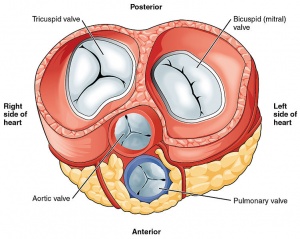Cardiac Valve Defects
Original Editor - Lucinda hampton
Top Contributors - Lucinda hampton and Aminat Abolade
Introduction[edit | edit source]
Key Facts
- Heart valves control blood flow to, from and within the heart.
- Damage to heart valves impairs the heart’s function.
- Heart valve disease is damage to the heart’s valve/s.
- Heart valve disease can be a treatable condition through medication or surgery[1]
Heart valve disease accounts for up to a third of heart diseases and is very common within the ageing population. When symptomatic, valve disease can have a significant negative effect on the patient’s ability to carry out daily physical activities and is also significantly associated with an increased risk of mortality and morbidity[2]
Types Of Valve Disease[edit | edit source]
There are a few types of heart valve disease. Some people may have a combination of more than one type of valve problem.
- Stenosis: valve doesn't work properly because the valve flaps are thick or stiff. This can reduce blood flow straining heart. Eg:
- One of the most common valve anomalies is aortic stenosis (AS), which is mainly caused by congenital defects, calcification on the valve, or Rheumatic valve disease. With aortic stenosis, the valve does not open fully, and thus, the heart must work harder to eject blood through the ventricle. As the heart continues to increase its workload to overcome the stenotic valve, the left ventricle can hypertrophy and subsequently develop pathologies such as heart failure[3].
2. Regurgitation (or insufficiency): valve flaps are ‘leaky’ and don't close properly. This lets blood leak back through the valve and makes the heart work harder to circulate blood around your body. Eg:
- Aortic regurgitation (AR). The common causes of AR are endocarditis, aortic dissection, and aortic leaflet rupture. In AR, the valves fail to shut completely thus allowing backflow of blood at the end of systole. This backflow decreases the total ejection fraction and creates a volume-overload state that will lead to an increased workload by the left ventricle and eventual left ventricular hypertrophy[3]
- Mitral valve prolapse (MVP). The most common causes of MVP include idiopathic degeneration of the valve, connective tissue disorders such as Marfan syndrome, and genetic causes. The pathophysiology of MVP involves inadequate positioning of the valve leaflets which create an overlapping, unsupported valve that loses its tension. This pathology causes the valve to prolapse out into the left atrium during systole, creating an opening that can cause regurgitation of blood into the left atrium.
3. Atresia: condition in which the valve isn't formed correctly, and tissue blocks the blood flow between the heart chambers. Eg:
- Aortic valvular atresia is a congenital condition in which the aortic valvular cusps are fused at birth. It frequently forms as a spectrum of malformations of the left ventricular outflow tract (LVOT). Most commonly, the defect presents as aortic stenosis, though in rare cases, it can manifest as complete atresia. When atretic, the valve can be dome-shaped, monocuspid, bicuspid, or even quadricuspid, and the associated leaflets are dysplastic or fused, not permitting flow through the abnormal valve[4].
Signs and Symptoms[edit | edit source]
Heart valve disease symptoms can be mild, moderate, or severe.
The signs and symptoms of heart valve disease include:
- Abnormal sound when listening with stethoscope (heart murmur)
- Chest pain
- Fainting, dizziness or light-headedness
- Irregular heartbeat
- Palpitations
- Shortness of breath
- Swelling of ankles and feet
- Tiredness
One of the first signs of heart valve disease is often a heart murmur. The murmur is heard when blood flows through a heart valve that doesn’t open or close properly (some people with a normal heart can have a murmur)[1].
Sub Heading 3[edit | edit source]
Resources[edit | edit source]
- bulleted list
- x
or
- numbered list
- x
References[edit | edit source]
- ↑ 1.0 1.1 Heart Foundation Heart Valve disease Available:https://www.heartfoundation.org.au/conditions/heart-valve-disease (accessed 21.4.2021)
- ↑ Anayo L, Rogers P, Long L, Dalby M, Taylor R. Exercise-based cardiac rehabilitation for patients following open surgical aortic valve replacement and transcatheter aortic valve implant: a systematic review and meta-analysis. Open heart. 2019 Apr 1;6(1):e000922.Available:https://openheart.bmj.com/content/6/1/e000922 (accessed 21.4.2021)
- ↑ 3.0 3.1 Oberman R, Bhardwaj A. Physiology, Cardiac. StatPearls [Internet]. 2020 Jul 21.Available: https://www.ncbi.nlm.nih.gov/books/NBK526089/(accessed 21.4.2021)
- ↑ Bandlamudi M, Ahmad M, Mungee S. Aortic Valvular Atresia. StatPearls [Internet]. 2020 May 13.Available: https://pubmed.ncbi.nlm.nih.gov/32491753/ (accessed 21.4.2021)







